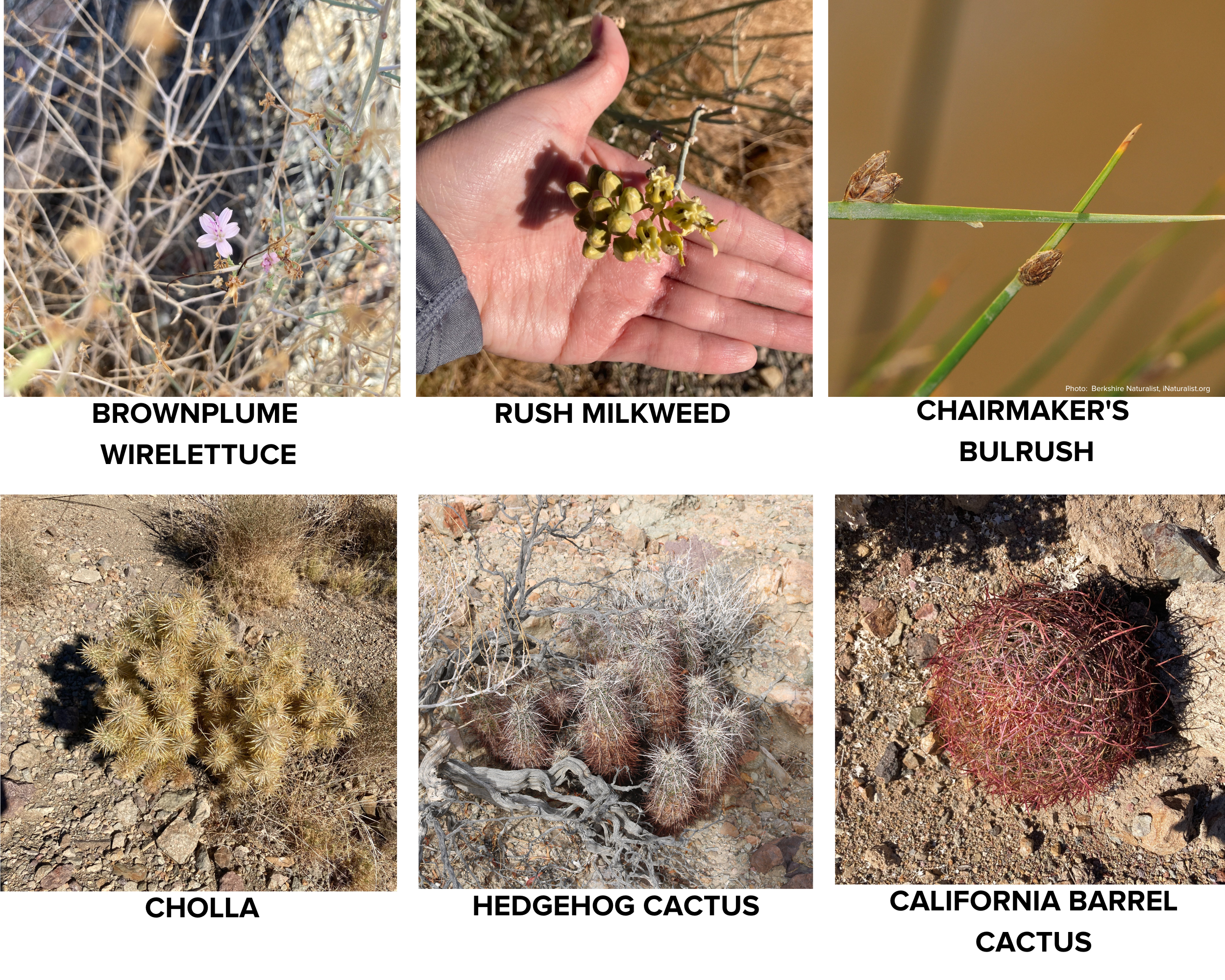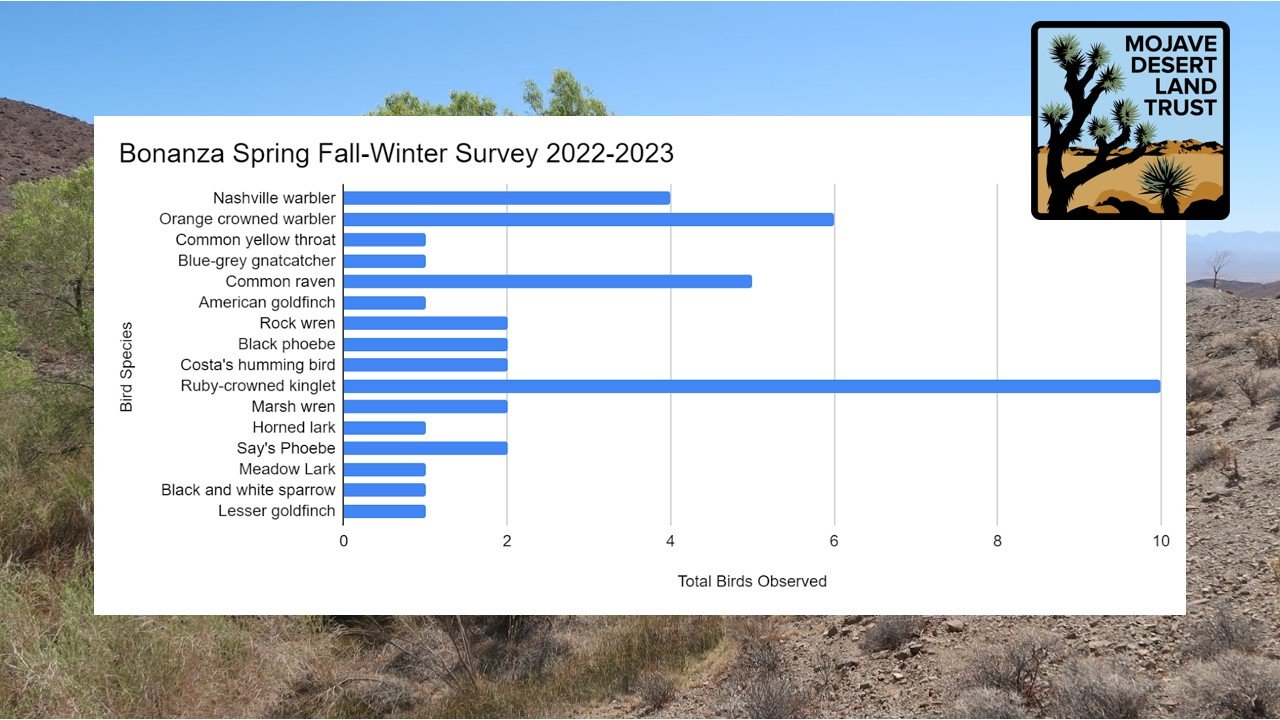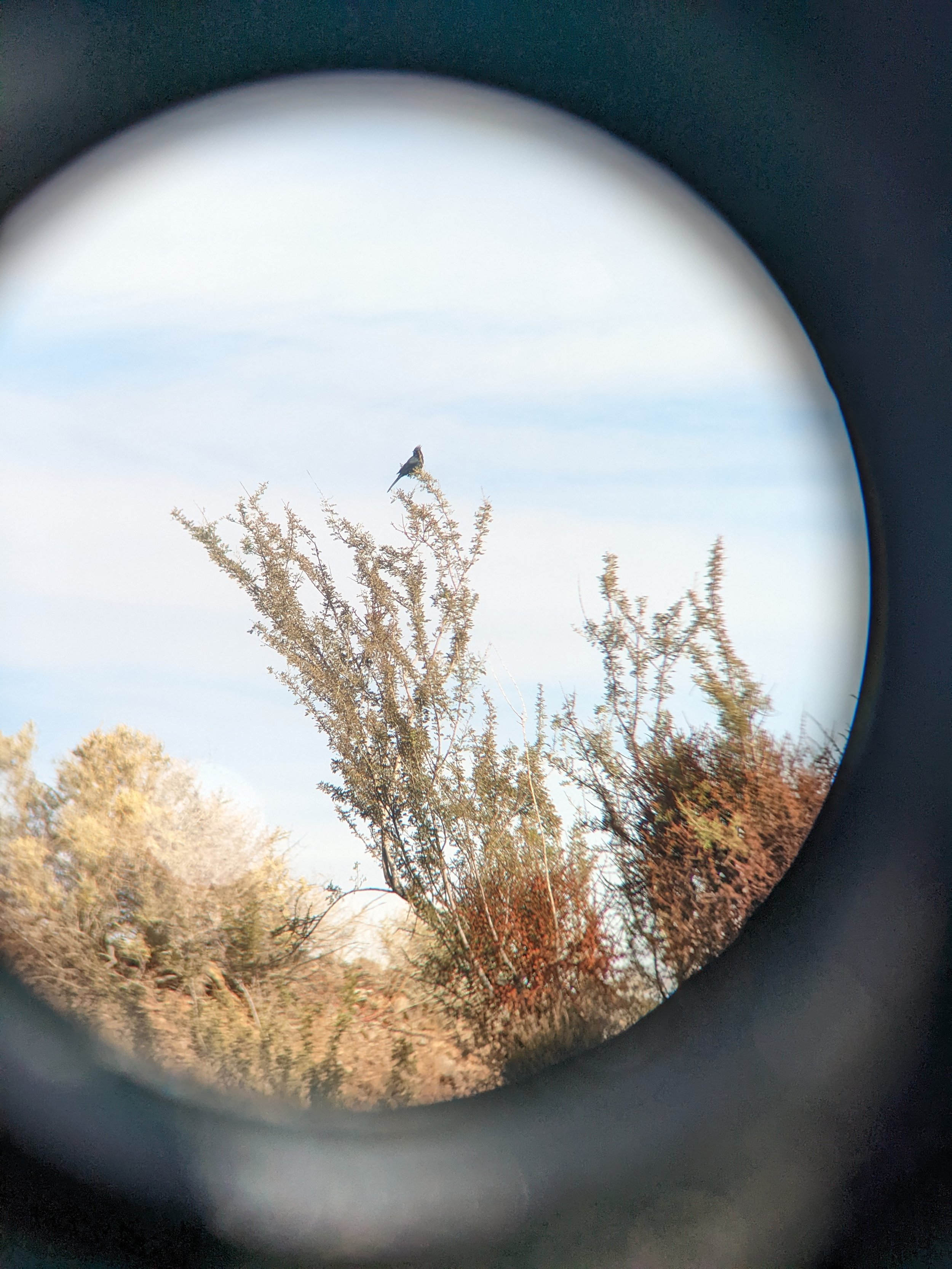Understanding a Mojave Desert oasis
By Karina Murillo, WISDOM intern
WISDOM interns birdwatching at Bonanza Spring in Mojave Trails National Monument. Photo: Mary Cook-Rhyne
Bonanza Spring is the largest freshwater spring in the southeastern Mojave Desert. From its 2,105 feet elevation in the low foothills of the Clipper Mountains, the spring’s freshwater is derived from a groundwater basin source.
Women In Science Discovering Our Mojave interns studied avian and bumble bee populations at Bonanza Spring in Mojave Trails National Monument between September 2022 and February 2023. This article explores the spring’s flora and fauna and data collected by the interns.
Plant biodiversity at Bonanza Spring
Top row: a few plants observed within the riparian zone of the spring.
Bottom row: a few desert plants we observed surrounding the outskirts of the spring.
Bonanza Spring is a wetland with a riparian zone situated on an alluvial fan. At first glance, the spring looks like an oasis surrounded by arid shrubland. At Bonanza Spring there are two types of phreatophyte vegetation (i.e., deep-rooted plants that get their water from groundwater): obligate and facultative. A few notable obligate phreatophytes that we observed at Bonanza Spring include chairmaker’s bulrush (Schoenoplectus americanus), Fremont’s cottonwood (Populus fremontii), southern cattail (Typha domingensis), western honey mesquite (Prosopis glandulosa) and black willow (Salix goodingii). A common facultative phreatophyte we encountered at the spring was saltgrass (Distichilis spicata). The surrounding xeric shrubland fauna had unique plants from the cacti genus: California barrel cactus (Ferocactus cylindraceus), beavertail cactus (Opuntia basilaris), and golden cholla (Cylindropuntia echinocarpa). We also observed a few desert flowering perennials: rush milkweed (Asclepias subulata) and brownplume wire-lettuce (Stephanomeria pauciflora).
The vegetation native to Bonanza Spring provides food and habitat for migratory and resident species. In addition, the native vegetation at the spring plays a critical role in hydrological and biogeochemical processes.
Wildlife biodiversity
At the surface water of the spring, we encountered tadpoles from the endemic red-spotted toad species (Anaxyrus punctatus). We also observed white mammal scat near the spring, presumably from a coyote or bobcat. A common reptile species we observed at the spring throughout the six-month survey was the western fence lizard (Sceloporus occidentalis). Alongside the spring, we observed several burrows ranging from 2–15 inches in diameter. These burrows could potentially be inhabited by common desert species: black-tailed jackrabbits, ground squirrels, kangaroo rats, and the elusive desert tortoise.
In addition, we observed several insect species: the black harvester ant (Veromessor pergandei), common blue damselfly (Enallagma cyathigerum), great black wasp (Sphex pensylvanicus), California bordered plant bug (Largus californicus), western honey bee (Apis mellifera), painted lady (Vanessa cardui), western tiger swallowtail (Papilio rutulus), and pallid-winged grasshopper (Trimerotropis pallidipennis).
The insects we observed were most abundant during the September and October months, which coincided with higher temperatures (87–99°F). The pallid-winged grasshopper was the most abundant insect during the fall months of October and November.
Furthermore, we noticed that the western honey bee was the most abundant pollinator species throughout our six-month survey. Since the western honey bee is an extreme generalist, it can exploit a variety of floral species and potentially outcompete native insect pollinators that are extreme specialists.
Noteworthy insect species we encountered between Fall 2022-Winter 2023.
Further surveys during the spring and summer months are recommended because of the emergence of diverse flowering plant species, which could provide insight into the variable changes in insect pollinator abundance.
During the fall season, neotropical migrants rest at migratory stopovers in Mojave Desert. A variable abundance of avian species can be observed at Bonanza Spring because of its shrubland and riparian habitats.
The avian surveys we conducted between September 2022-February 2023 indicate that songbirds (i.e., warblers) were the most abundant during this migration season. During the fall months, we observed a high number of migratory warbler species: Nashville warbler (Leiothlypis ruficapilla), orange crowned warbler (Vermivora celata), and common yellowthroat (Geothlypis trichas). Throughout our six-month survey, the common raven and the ruby-crowned kinglet were the most abundant. The common raven is a highly opportunistic bird that can thrive in a diverse range of habitats, so it was expected that we would encounter this bird throughout the six-month survey.
The avian surveys we conducted between September 2022-February 2023 indicate that songbirds (i.e., warblers) were the most abundant during this migration season. During the fall months, we observed a high number of migratory warbler species: Nashville warbler (Leiothlypis ruficapilla), orange crowned warbler (Vermivora celata), and common yellowthroat (Geothlypis trichas). Throughout our six-month survey, the common raven and the ruby-crowned kinglet were the most abundant. The common raven is a highly opportunistic bird that can thrive in a diverse range of habitats, so it was expected that we would encounter this bird throughout the six-month survey.
New data
WISDOM interns visited Arrowweed and Bonanza springs over a six-month period in 2022 and 2023 to study birds and bumble bees. The citizen science data collected by the interns is the first of its kind at these two oases. Read about the new data collected here.
Why conservation matters
Desert springs such as Bonanza Spring are ecological hotspots to support biodiversity and are composed of unique desert communities. The spring provides several ecological services: migratory stopover, water provision, and habitat. The unique phreatophyte plant community found exclusively at the spring is highly dependent on groundwater because of its deep-rooted system. Wildlife are dependent on the fauna for food and water provision.
Desert springs such as Bonanza are rarities that attract a diverse array of species, including the bighorn sheep and the desert tortoise. It is in our best interest to conserve Bonanza Spring because of its significance to wildlife and people.
Data provides rare insights into Mojave summer birds, bees
New data collected by WISDOM interns offers rare insights into the summer bird populations at two oases in the Mojave Desert.
WISDOM is an MDLT internship program in collaboration with the Bureau of Land Management that seeks to help engage women from underserved communities studying Science, Technology, Engineering, and Math (STEM). This internship fosters an environment of mentorship and career exploration by connecting female students with researchers and professionals, helping to develop the next generation of scientists. Find out more.






